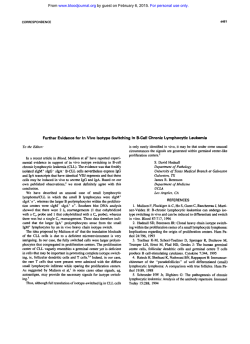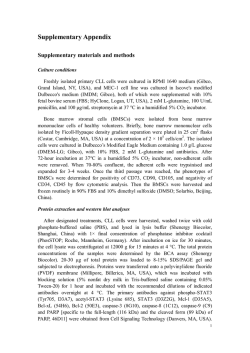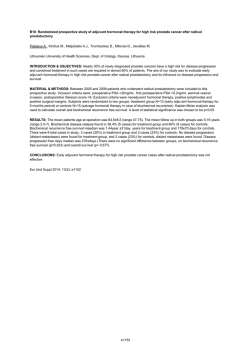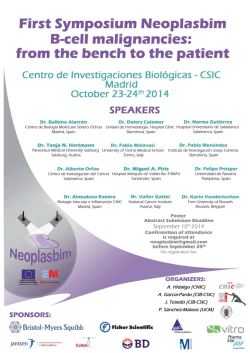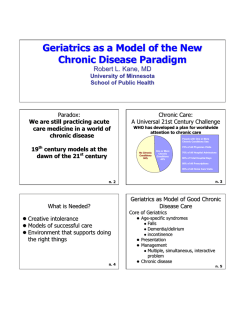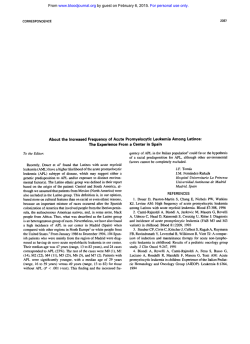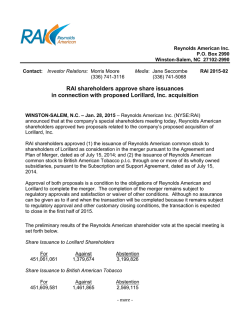
Progression and Survival Studies in Early Chronic
From www.bloodjournal.org by guest on February 6, 2015. For personal use only. Progression and Survival Studies in Early Chronic Lymphocytic Leukemia By Stefano Molica To investigate the natural history of stage A chronic lymphocytic leukemia (CLL) we reviewed 84 such patients. Among 74 cases evaluable for disease progression, 22 (29.6%) progressed to more advanced clinical stages (9 to stage B,l3 to stage C); the actuarial estimation of such an event at 4 years was 30% (95% CI: 26.3% to 33.6%). Despite a linear trend toward an increasing risk (r = .92), the hazard function analysis showed a constant pattern of progression, suggesting a lack of correlation of such an event with time (r = .04). Furthermore, disease progression when analyzed as a timedependent variable had a clear-cut impact on survival (P < .OOl). With the aim of identifying a subgroup of patients with low probability of disease progression and death, we applied to our set of patients four different proposals for subclassifying stage A. All methods were similar in terms of sample size, 5-year survival rate, and disease progression risk, suggesting that the choice between different proposals is somewhat arbitrary. Whatever the criteria are for defining ”smoldering“ CLL, such patients (accounting in the present study for 20.5% of overall series and 46.7% of stage A patients) should not be treated until progression occurs. o 1991by The American Society of Hematology. C more. Patients in whom enlarged lymphnodes antedated the appearance of peripheral blood lymphocytosis were considered to have diffuse well-differentiated lymphoma (DWLL) and were not included in this analysis, as well as patients with prolymphocytic leukemia’ or “prolymphocytoid” transformation of CLL.” B-cell phenotype was demonstrated in all patients by means of immunologic markers (IgS, E-rosettes). A panel of monoclonal antibodies (MoAbs), CD5, CD3, and HLA-DR, was incorporated to study the last 52 diagnosed patients.” BM biopsies were performed only in 40 patients. Four histologic patterns were recognized: nodular, interstitial, mixed, and difise.12 Lymphocyte doubling time (LDT), defined as the time taken to double the lymphocyte count found at the diagnosis,was calculated either directly (in 31 cases) or by means of a linear regression (in 43 cases). Disease progression was defined as the change to a more advanced clinical stage than that present at diagnosis (eg, from stage A to B or C). Both LDT and disease progression were assessed as long as patients remained untreated. As far as the sub-classification of stage A is concerned, four proposals were applied to our set of patients.2s,78Table 1 depicts different methods tested: one based on Rai’s classification: one on Montserrat’s proposal,’ and two on the successive proposals of French Cooperative Group on CLL.?.* Treatmentand follow-up data. All patients were treated according to the conventionally accepted methods. Indications for treatment were progressive disease with clear B-symptoms (fever, night sweats, or weight loss not resulting from other causes), progressive lymphadenopathy, anemia, and thrombocytopenia with hemoglobin levels consistently less than 10 g/dL, or platelet count decreasing to less than 100 x 109/L.Fifty-three patients did not receive any treatment after periods ranging from 6 to 204 months. An alkylating agent, usually chlorambucil associated with low doses of corticosteroids,was the drug chosen for the remaining 31 patients after periods ranging from 1 to 58 months (median, 16 months). As far as survival is concerned, median duration of follow-up for the whole series of stage A patients was 45 months (range, 6 to 204 months). Statistical methods. End points considered in this study were LINICAL STAGING systems have provided useful tools for assessing the prognosis and planning therapy in chronic lymphocytic leukemia (CLL). In patients with advanced disease (Binet’s stage B or C, or Rai’s stage 11,111, or IV)’z’ median survival is less than 5 t o 6 years. Generally, these patients need treatment at the time of diagnosis or early during the follow-up period, In patients in early clinical stage (Binet’s stage A or Rai’s stage 0 or I) survival can b e very long (10 years or more) and treatment can be often delayed. However, a certain number of patients progress to a more advanced clinical stage and eventually die of their disease. Because a t diagnosis up t o 50% of CLL patients are in early clinical stage, the question concerning the nature and management of such cases is of great importance. T h e few studies dealing with disease progression in CLL have yielded inconclusive results.324In 1988, Montserrat e t al’ first proposed criteria t o identify patients with “smoldering” CLL (namely, stage A, non-diffuse bone marrow [BM] histology, hemoglobin level 2 13 g/dL, lymphocyte value < 30 x 109/L,lymphocyte doubling time > 12 months). More recently, in an International Workshop on CLL meeting6 the natural history of early CLL was further discussed. Analysis of patients followed-up a t a single institution or entered into randomized clinical trials indicates that a definition of “smoldering” CLL is possible. This finding is of clinical relevance because such patients should not be treated unless progression is observed. In this report we investigated the natural history of 84 patients with early CLL followed-up a t a single institution. In addition, we tried to validate different proposals for defining “smoldering” CLL by using our patients as test-set MATERIALS AND METHODS Patient population. Among 195 patients diagnosed as having CLL at our institution, 84 (43%) were in Binet’s stage A. Fifty-three were males and 31 females. Average age was 65.6 years (SD, 8.5). Forty-one patients were classified as being in Rai’s stage 0, 13 in I, and 30 in 11, respectively. Clinical observations were always made by the same person (S.M.). Diagnostic criteria. CLL diagnosis was established according to the conventionally accepted methods.’ Eighteen patients whose absolute lymphocyte count was less than 15 x 10y/Lat the time of diagnosis (5 to 10 X 109/Lin 10 patients, 11 to 14 x 109/L in 8 patients) were included in this study. All patients who were observed eventually showed blood lymphocytes of 15 x 10y/Lor Blood, VOI 78, NO4 (August 15). 1991: pp 895-899 From the Diviswne di Ematologia, Ospedale Regionale ‘2. Pugliese, ” Catanzaro, Italy. Submitted July 31,1990; accepted March 14, 1991. Address reprint requests to Stefano Molica, MD, via Casalinuovo, 6, 88100 Catunzaro, Italy. The publication costs of this article were defrayed in part by page charge payment. This article must therefore be hereby marked “advertisement” in accordance with 18 U.S.C. section I734 solely to indicate this fact. 0 I991 by The American Sociey of Hematology. 0006-4971/91/7804-0129$3.00/0 895 From www.bloodjournal.org by guest on February 6, 2015. For personal use only. STEFAN0 MOLICA 896 Table 1. Different Proposals for Defining "Smoldering" CLL Rai et al' 1.Hb r l l g/dL 2. PLT 2100 x 10g/L 3. No involved areas Montserrat et a15 French Group' 1. Stage A 2. Non-diffuse BM histology 3. Hb r 13 g/dL 4. PB lymphocytes <30 x 10g/L 5.LDT > 12 mo 1.Hb r12g/dL 2. PB lymphocytes <30 x 107L French Group' 1.Hb r12gldL 2. PB lymphocytes <30 x 109/L 3. BM lymphocytes <80% 4. Less than two areas involved Abbreviations: Hb, hemoglobin; PLT, platelets; PB, peripheral blood. 21 20 Y I 13 11 Y S t a g e A I01 rz0.44 062. 42 g A 010. U ;0.08. Y 5 VJ 0.04 . 0.02 S t a g e A [I-111 z .-v) 0.06. a: 0.3- P C 0.001 0.2 . Patients a t risk A 72 70 60 44 36 1 2 3 4 5 25 20 6 7 years 16 0.1- 8 i Fig 1. Hazard survival function of stage A patients. Regression analysis for a linear function results in a correlation coefficient of I = .44. (A) Hazard function. (W) Regression line. progression and survival. Median time of treatment-free disease was 28 months (range, 6 to 204 months). Ten patients who were treated within 6 months from diagnosis were excluded from the analysis of disease progression. Survival curves and curves of disease progression were plotted according to the method of Kaplan and Meier'' and compared by using the log-rank test.14 To determine the influence of disease progression in the patients' survival, this event was analyzed as a time-dependent one according to the method of Mantel and Byar." The hazard function analysis was performed as suggested by Simes and Ze1en"to evaluate how the risk of each event varied over time. RESULTS Survival. At the time of this report, 20 patients had died. Median survival for all stage A patients was not reached, the 8-year survival rate was 52% (95% CI: 38% to 66%). More detailed information on the pattern of failure is given by the hazard survival analysis. As it can be seen in 1 2 3 4 5 6 7 years Fig 2. Actuarial survival curves of stage A CLL patients according to Rai's substages. The projected survival at 10 years was 87% (95% CI: 74% to 100%)for substage A (0)and 28% (95% CI: 13% to 59%) for substage A (It o 11). Fig 1, the risk of dying increases progressively as a linear function of time (r = .44). As far as Rai's clinical sub-stages are concerned, the 8-year rates of survival were 84% (95% CI: 74% to 99%) for stage 0, 30% (95% CI: 6% to 54%) for stage I, and 40% (95% CI: 18% to 62%) for stage I1 (P < .001). Due to the lack of significant difference between patients in stage A (I) and A (11) in the graphic representation of survival, they were grouped together (Fig 2). The influence on survival was also evident for LDT. Clear-cut differences were found between patients who doubled their initial lymphocyte count and those who did not (Table 2). Disease progression. Twenty-two (29.6%) of 74 stage A patients progressed to a more advanced clinical stage (9 to B and 13 to stage C) during the observation period. The Table 2. Log-Rank Analysis of Survival Probability and Disease-Progression Risk According to the Doubling Time of Peripheral Blood Lymphocytes No. of Patients Observed Expected OiE XZ PValue 43 31 6 12 10.57 7.41 0.56 1.61 4.81 < .05 43 31 5 17 12.91 0.38 1.87 11.75 < ,001 Survival LDT (no) LDT (yes) Disease progression LDT (no) LDT (yes) Abbreviation: O/E, relative death rate. 8 9.07 From www.bloodjournal.org by guest on February 6, 2015. For personal use only. NATURAL HISTORY OF STAGE A CLL 897 Table 3. Hazard Function and Actuarial Risk of Disease Progression for Stage A CLL Patients Years Follow-up Patients at Risk Actuarial Risk (tSE) Hazard Function ( 2 SE) 0-1 1-2 2-3 3-4 4-5 5-6 6-7 7-8 74 62 48 37 28 24 20 16 9.8% (k0.02) 19.3% (20.06) 27.4% (20.08) 30.0% (20.08) 32.7% (aO.10) 36.1% (k0.16) 36.1% (kO.19) 39.8% (20.20) 10% (20.03) 11% (20.03) 10% (k0.03) 3.5% (20.009) 4.7% (kO.01) 5.0% (20.02) 6.0% (aO.O1) 6.0% (kO.01) Regression analysis for a linear function results in a correlation coefficient of r = .92 for the actuarial risk and of r = .04 for the hazard function analysis, respectively. Table 4. Characteristics of Stage A Patients: Progressed Versus Non-Progressed No. of patients Sex (M/F) Age (y), mean k SD Hb (g/dL), mean 2 SD Lymphocytes (lOs/L) Platelets (109/L) LDT>12mo E M histology (diffuse/non-diffuse) Rai‘s substages (O/I to II) Causes of death (CLUnon-CLL-related) Stage A Non-Progressed Stage A Progressed 52 (70.2%) 38/14 64.3 k 8.7 13.8 k 1.4 19.6 2 10.2 194.3 a 60.7 94% 1/29 33119 2/4 22 (29.7%) 11/11 66.5 k 8.7 12.8k 1.3 24.0 k 9.8 177.1 2 58.9 60% 3ff 3/19 11/1 P Value NS NS <.01 < .05 NS < ,0005 < .002 < .0005 < .01 Abbreviation: NS, not significant. actuarial progression risk at 4 years was 30% (95% CI: 26.3% to 33.6%). Despite a linear trend toward an increasing risk (r = .92), the hazard function analysis showed a constant pattern of progression, suggesting a lack of correlation of such an event with time (r = .04) (Table 3). Table 4 depicts the main characteristics of 74 stage A patients from the whole series that, according to their outcome, could be classified as “progressed” and “nonprogressed,” respectively. As shown, Rai’s stage 0 accounts for the majority of non-progressed cases (33 of 52; 63%). Furthermore, lower hemoglobin level, higher lymphocyte count, which progressively increased in number, and diffuse BM disease were all associated with disease progression. More important, perhaps, was the fact that disease progression, when analyzed as a time-dependent variable, had clear-cut impact on survival (P < .001) (Fig 3). In this context it was of interest that progressed stage A patients died more frequently of CLL-related causes than nonprogressed ones (E‘ < .01). “Smoldering” CLL. In Table 5 are displayed four ways for sub-classifying stage A CLL patients applied to our series. Results of different proposals were similar in terms of sample size, 5-year survival rate, and disease progression risk. Patients fulfilling criteria of “smoldering” CLL accounted for 20.5% of overall series and 46.7% of all stage A cases. highly heterogeneous and, therefore, treatment decisions can be difficult. CLL staging systems provide useful tools for predicting survival and planning therapy. However, they have some limitations, the most important of which is their inability to distinguish between patients with early disease who will remain stable for many years and require no therapy and those who will develop progressive disease and require treatment. Some investigators have attempted to address this problem by analyzing the effect of rapidly increasing lymphocyte COUnt4,17-19 and a diffuse BM histology on the disease.”22 U Overall series a7 \ 0.6 - 05> m .L > Mantel-Byar Progressed I DISCUSSION CLL is the most frequent type of leukemia in Western countries for which at present there is no curative treatment. The survival probability of patients with CLL is 1 1 2 3 4 5 6 7 8 years Fig 3. Survival of stage A patients according to the disease progression. From www.bloodjournal.org by guest on February 6, 2015. For personal use only. STEFAN0 MOLICA 898 Table 5. Sample Sizes, Rates of Survival, and Disease Progression Risk According to Four Proposed Classifications of Stage A Patients Rates of Survival Subgroups Rai et all Stage 0 Stage I to I1 Montserrat et al’ Smoldering Active French Group’ A‘ Nt No. of Patients ( O h ) 5-year 10-year (95% CI) Disease Progression Risk 5-year (95% CI) 41 (48.8%) 43 (51.1%) 92% 51 % 87% (95% CI: 71% to 99%) 28% (95% CI: 13% to 59%) 13% (95% CI: 12% to 14%) 47% (95% CI: 31 Yo to 62%) 40 (54%) 34 (46%) 92% 53% 85% (95% CI: 74% to 100%) 26% (95% CI: 7% to 45%) 14% (95% CI: 12% to 14%) 53% (95% CI: 32% to 74%) 39 (46.4%) 45 (53.5%) 93% 53% 87% (95% CI: 74% to 100%) 25% (95% CI: 6% to 44%) 14% (95% CI: 12% to 16%) 53% (95% CI: 33% to 73%) 39 (46.4%) 45 (53.5%) 93% 55% 87% (95% CI: 75% to 99%) 26% (95% CI: 12% to 58%) 15% (95% CI: 14% to 16%) 52% (95% CI: 33% to 69%) French Group* A, A* Han et a13reported an interesting retrospective group of 20 patients with Rai’s stage 0 who had normal karyotype and stable disease for 6.5 to 24 years. This form of CLL has been defined “benign monoclonal lymphocytosis.” However, in most studies it has been considered that it is not possible to identify patients unlikely to progress and with prolonged survival probability after diagnosis. Twenty-two (29.6%) of the 74 patients included in this study progressed to a more advanced clinical stage. This result is in agreement with 26.4% reported by Montserrat et al’ and with 25.2% reported by the French Cooperative Group on CLL.’ Because progression affects overall survival, it is important to define criteria to identify a subgroup of patients with low probability of disease progression and death. Montserrat et al’ first proposed the definition of “smoldering” CLL for stage A CLL patients whose survival was not different from that of sex- and age-matched controls. The need of a better understanding of the natural history of stage A CLL patients has been considered in a recent International Workshop on CLL meeting.6 The analysis of large series followed-up at a single institution or entered into randomized clinical trials allowed the identification of stage A patients in whom disease may progress and survival is likely to be shorter. Clinical and laboratory indicators of such events were: high lymphocyte count, short LDT, diffuse BM histology, relatively low hemoglobin concentration, and sub-stage A (I to 11). More recently, the results of the French Cooperative Group on CLL suggested that a definition of “smoldering” CLL is possible, although the choice between different proposals remains somewhat arbitrary? In our set of patients we confirm that, whatever the proposal used for defining “smoldering” CLL sample size, 5-year survival rate and disease progression risk are similar. Although the International Workshop on CLL recommended to integrate Binet’s and Rai’s stages,23the studies dealing with this issue are virtually absent. As shown in our study, stage A patients are heterogeneous with regard to prognosis and, consequently, the separation for prognostic purpose of stage A (0) from stage A (I to 11) is mandatory. As far as patients in Rai’s stage I are concerned, their pattern of survival was not different from that of patients in stage 11. RaiZ4had already observed that there are three (0, I to 11, and I11 to IV) rather than five groups that differ with respect to survival. In conclusion, in patients in early CLL disease progression is a constant risk that is associated with shortened survival. Rai’s substage 0, non-diffuse BM histology (both at diagnosis), and high LDT as a dynamic parameter during follow-up all identify within stage A a sub-group with low probability of disease progression and death. In addition, what emerges from this study is that recent proposals of “smoldering” CLL can be successfully applied to other series. The study of some biologic parameters such as the cells’ karyotype may help to identify in the future those patients who will eventually require treatment. REFERENCES 1. Binet JL, Auquier A, Dighiero G, Chastang C, Piguet H, Goasguen J, Vaugier G, Potron G, Colona P, Oberling F, Thomas M, Tchernia G, Jacquillat C, Boivin P, Lesty C, Duault MT, Monconduit M, Belabbes S, Gremy F: A new prognostic classification of chronic lymphocytic leukemia derived from a multivariate survival analysis. Cancer 48:198,1981 2. Rai KR, Sawitsky A, Cronkite EP* Chamna RM, Pasternack BS: Clinical staging of chronic lymphocytic leukemia. Blood 46:219, 1975 3. Han T, Ozer H, Gavignan M, Gajera R, Minowada J, Bloom M, Samadori N, Sandberg AA, Gomez GA, Henderson ES: Benign monoclonal B cell lymphocytosis: A benign variant of CLL. Clinical, immunological, phenotypic and cytogenetic studies in 20 patients. Blood 64:244,1984 4. Tura S, Cavo M, Baccarani M: Stage 0 chronic lymphocytic leukemia, in Gale RP, Rai KR (eds): Chronic Lymphocytic Leukemia: Recent Progress and Future Direction. UCLA Symposia on Molecular and Cellular Biology (vol 59). New Series. New York, NY, Liss, 1987, p 265 5. Montserrat E, Vifiolas N, Reverter JC, Rozman C: Natural history of chronic lymphocytic leukemia: On the progression and prognosis of early clinical stages, N~~~ R~~ F~ Haematol 30~359, 1988 6. International Workshop on CLL: Prognostic features of early chronic lymphocytic leukemia. Lancet 2:968,1989 7. French Cooperative Group on Chronic Lymphocytic Leukemia: Effects of chlorambucil and therapeutic decision in initial From www.bloodjournal.org by guest on February 6, 2015. For personal use only. NATURAL HISTORY OF STAGE A CLL forms of chronic lymphocytic leukemia (stage A): Results of a randomized clinical trial on 612 patients. Blood 75:1414,1990 8. French Cooperative Group on Chronic Lymphocytic Leukemia: Natural history of stage A chronic lymphocytic leukaemia untreated patients. Br J Haematol76:45,1990 9. Galton DAG, Goldman JM, Wiltshaw E, Catovsky D, Henry K, Goldenberg GJ: Prolymphocytic leukaemia. Br J Haematol277, 1974 10. Enno A, Catovsky D, O’Brien M, Cherchi M, Kumaran TO, Galton DAG: “Prolymphocytoid” transformation of chronic lymphocytic leukaemia. Br J Haematol41:9,1979 11. Molica S, Alberti A Investigation of nuclear clefts as a prognostic parameter in chronic lymphocytic leukemia. Eur J Haematol41:62,1988 12. Rozman C, Montserrat E, Rodriguez-FernandezJM, Ayats R, Vallespi T, Parody R, Rios A, Prados D, Morey M, Gomis F, Alcala A, Gutierrez M, Maldonado J, Gonzales G, Giralt M, Hemandez-Nieto L, Cabrera A, Fernandez-Rafiana JM: Bone marrow histological pattern. The best single prognostic parameter in chronic lymphocytic leukemia: A multivariate survival analysis of 329 cases. Blood 64542,1984 13. Kaplan EL, Meier P: Non-parametric estimation of incomplete observations. J Am Stat Assoc 53:457,1958 14. Pet0 R, Pike MC, Armitage P, Breslow NE, Cox DR, Howard SV, Mantel N, McPherson K, Pet0 J, Smith PG: Design and analysis of randomized clinical trials requiring prolonged observation of each patient. 11. Analyses and examples. Br J Cancer 35:1,1977 15. Mantel N, Byar P: Evaluation of response-time data involving transient states: An illustration using heart-transplant data. J Am Stat Assoc 69:81,1974 899 16. Simes RJ, Zelen M: Explanatory data analysis and the use of hazard function for interpretering survival data: An investigator’s primer. J Clin Oncol3:1418,1985 17. Galton DAG: The pathogenesis of chronic lymphocytic leukemia. Can Med Assoc J 94:1005,1966 18. Montserrat E, Sanchez-Bison6 J, Vifiolas N, Rozman C: Lymphocyte doubling time in chronic lymphocytic leukaemia: Analysis of its prognostic significance.Br J Haematol62567, 1986 19. Molica S, Alberti A: Prognostic value of lymphocyte doubling time in chronic lymphocytic leukemia. Cancer 602712,1987 20. Montserrat E, Rozman C Clinicopathologic staging of chronic lymphocytic leukemia, in Gale RP, Rai KR (eds): Chronic Lymphocytic Leukemia: Recent Progress and Future Direction. UCLA Symposia on Molecular and Cellular Biology (~0159).New Series. New York, NY,Liss, 1987, p 215 21. Pangalis GA, Boussiotis VA, Kittas C: B-chronic lymphocytic leukemia. Disease progression in 150 untreated stage A and B patients as predicted by bone marrow pattern. Nouv Rev Fr Haematol30:373,1988 22. Raphael M, Chastang C, Binet JL Is bone marrow biopsy a prognostic parameter in B-CLL? Nouv Rev Fr Haematol 30:377, 1988 23. International Workshop on CLL Chronic lymphocytic leukaemia: A new proposal for a revised prognostic staging system. Br J Haematol98:365, 1981 24. Rai KR: A critical analysis of staging in CLL, in Gale RP, Rai KR (eds): Chronic Lymphocytic Leukemia: Recent Progress and Future Direction. UCLA Symposia on Molecular and Cellular Biology (vol59). New Series. New York, NY,Liss, 1987, p 253 From www.bloodjournal.org by guest on February 6, 2015. For personal use only. 1991 78: 895-899 Progression and survival studies in early chronic lymphocytic leukemia S Molica Updated information and services can be found at: http://www.bloodjournal.org/content/78/4/895.full.html Articles on similar topics can be found in the following Blood collections Information about reproducing this article in parts or in its entirety may be found online at: http://www.bloodjournal.org/site/misc/rights.xhtml#repub_requests Information about ordering reprints may be found online at: http://www.bloodjournal.org/site/misc/rights.xhtml#reprints Information about subscriptions and ASH membership may be found online at: http://www.bloodjournal.org/site/subscriptions/index.xhtml Blood (print ISSN 0006-4971, online ISSN 1528-0020), is published weekly by the American Society of Hematology, 2021 L St, NW, Suite 900, Washington DC 20036. Copyright 2011 by The American Society of Hematology; all rights reserved.
© Copyright 2025
